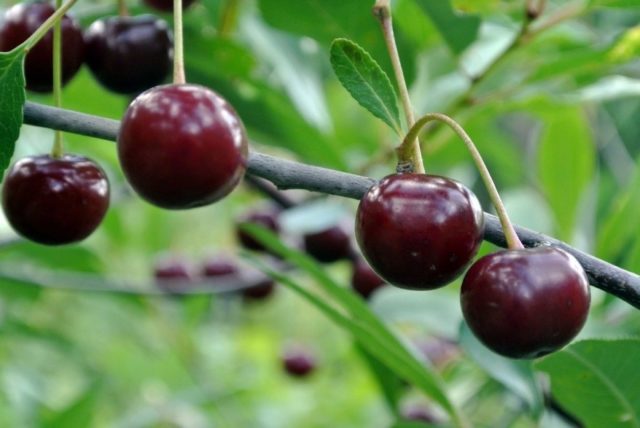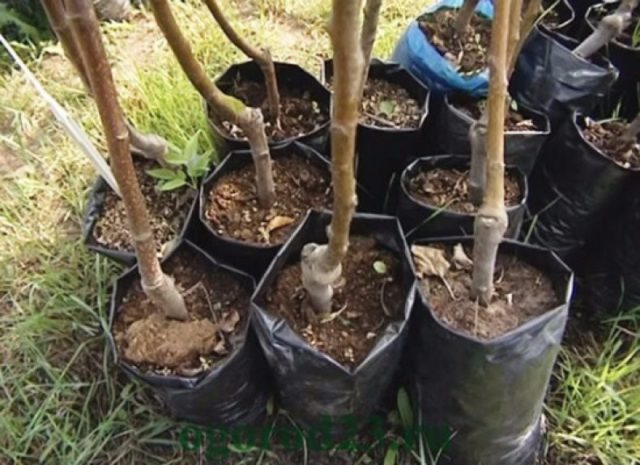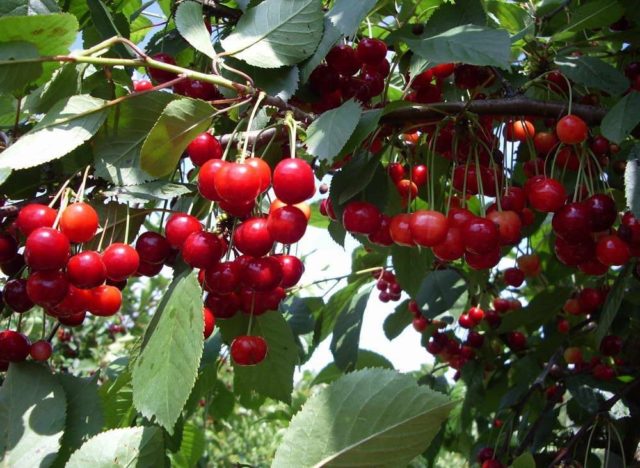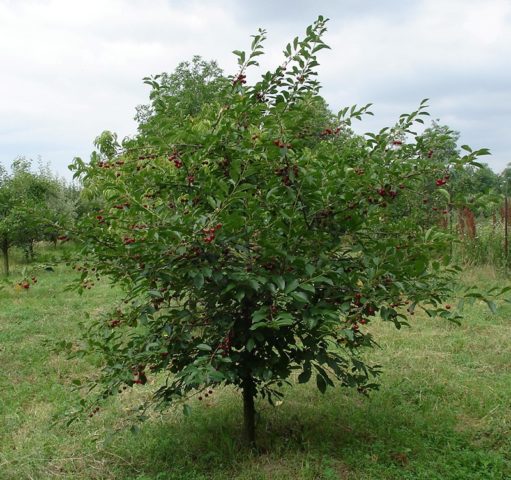Content
Cherry Assol is a mid-season fruitful variety, bred recently. Included in the State Register since 2010. The self-pollinated variety fell in love with summer residents for its simplicity, drought resistance and frost resistance, as well as for its universal fruits.
Many gardeners believe that varieties that do without pollinators will still increase yields if trees of this type grow nearby.
Description of Assol cherry variety
Breeders recommend growing Assol cherries in the Central Region. During its spread, the variety gained popularity in the Moscow region, but it is planted not only here, even in the Urals and Siberia, but also in the southern regions.
Height and dimensions of an adult tree
The Assol variety has a medium-sized tree, convenient for careful maintenance and for harvesting fruits:
- rises up to 2-2.5 m;
- pyramidal crown broadly spreading, rounded, with slightly drooping or straight shoots;
- not prone to thickening;
- the bark of the branches is brown, smooth.
The tree is fast-growing - by the beginning of fruiting, 3-4 years after planting, it reaches the declared height - no more than 3 m. The medium-sized leaves are somewhat elongated, obovate, of the usual dark green color, with a pointed tip. The leaf blades are slightly wrinkled, dull, with finely serrated edges.
Without proper pruning, it can turn into a shrub, since shoots grow densely from below.
Description of fruits
Assol cherries according to the description of the variety and a photo of medium size - 4-4.2 g. Fruits are round, with a juicy sweet and sour pulp. A small bone separates well from the pulp. The berries contain 15% dry matter, 10% sugar, 1.3% acid. Tasters rated Assol cherry fruits at 4.7 points. Cherries in the phase of full ripeness cannot be left on the branches for a long time, since, although they hold on to the stalks, they quickly lose their taste and quality of dense, elastic pulp. The Assol variety is suitable for planting in the southern regions, the fruits tolerate the sun well.

The peel of the Assol variety is dark red, the same color and pulp
Cherry pollinators Assol
The tree blooms in the recommended growing regions mainly by mid-May, the flowering period is short. The variety is self-fertile. Cherry authors point out that this property of the tree does not affect the volume of the harvest.
Main characteristics of Assol cherries
The mid-season Assol cherry variety, judging by the photo and description of the variety, is fruitful. From a medium-sized tree, 10-12 kg of juicy and tasty berries are harvested.
Drought resistance, frost resistance
Since Assol cherry was bred for the central regions of Russia, the tree has an average winter hardiness and at the same time is drought-resistant. The variety is suitable for cultivation in the 4th zone of frost resistance, which includes many regions of Russia. The wood can withstand frost up to 30 ° C. Like many cherry trees, Assol tolerates long periods of drought, but with regular, infrequent watering, the yield increases significantly.
Yield
The seedling is formed over 3-4 years. The first fruits appear in the 3-4th, sometimes in the 5th year after planting.At first, the yield is low, then after 2 years it increases to 7 or 10-15 kg per tree. The berries of the mid-season Assol variety are filled with juice by the end of June. Fruiting lasts until early July. The berries need to be picked quickly as they spoil, especially on rainy days.
Cherry yield depends on:
- from soil fertility;
- correct planting of the seedling;
- competent watering and dressing.
Juicy, soft cherries do not travel long distances. Transportation for 100-200 km is possible:
- in a container of small volume;
- in sealed packaging;
- if the berries are plucked with stalks.
The berries retain their presentation up to 20 hours. In the refrigerator - up to 2 days. Assol cherry fruits are universal in purpose. They are used fresh as a dessert and for various preparations.
Advantages and disadvantages
Gardeners are attracted by the positive properties of the Assol variety:
- self-fertility;
- good productivity;
- resistance to certain diseases characteristic of the culture;
- the adaptability of wood to the climatic conditions of the Central region of Russia, which includes such characteristics as frost resistance and drought resistance.
As a disadvantage, some gardeners note the excessive acidity of the berries. The reason for this property is an illiterate excessive watering, a rainy summer, or the collection of fruits that have not reached the full ripeness phase.
Planting Assol cherries
Compliance with the requirements of agricultural technology when planting a cherry tree predetermines its further development and fruiting. It is important to pay attention to every stage of building a culture.
Recommended timing
In the climate of the middle zone, cherries are recommended to be planted in spring at the end of April, early May. Over the summer, the tree takes root, grows stronger, grows its crown and subsequently easily tolerates winter.

Having bought a seedling with a closed root system, it is also better to move the cherry to a permanent place at least until mid-June
Site selection and soil preparation
The Assol cherry variety is unpretentious, develops well and bears fruit on any type of soil, but the best results are obtained on soils with neutral acidity.
When planting cherries, you need to find a place for the tree in the garden that meets the following requirements:
- groundwater is not higher than 2 m to the surface of the earth;
- the plot is sunny, not shaded by buildings and tall ornamental trees;
- not blown by northerly winds;
- placing several cherries, they dig planting holes at a distance of at least 3-4 m so that the tree crowns are well ventilated.
How to plant correctly
High-quality Assol cherry seedlings are chosen according to the following criteria:
- the age of the tree is 1-2 years;
- height from 1 to 1.5 m;
- trunk diameter - 1.5 cm;
- on a tree at least 10 branches, up to 50 cm long;
- the length of the root processes is at least 25 cm.
At the selected site, a planting hole is dug up to a depth of 50-70 cm and the same width. A larger volume is chosen if a special substrate is laid on soils that are not favorable for cherries. On clay soil, part of humus, sand, peat is added to the upper fertile layer. If the soil is predominantly peat or sandy, part of the clay and humus is mixed into the pit. 500 ml of wood ash, 25-30 g of potassium chloride, 50-60 g of superphosphate are added to the planting substrate.
Before planting, the roots of the cherry are soaked in a clay mash for several hours. Selected growth promoters are added to the mixture as desired.
Care features
The tree is not picky. With proper watering and feeding, it shows good yield.
Watering and feeding schedule
In the first year of growth, Assol cherries are watered 1-2 times a week. The trees are watered four times a month if there is no rain.
Superphosphate and wood ash are used as fertilizers, adding substances along the perimeter of the crown two or three times over the summer. In early spring and after flowering, nitrogen fertilizers are used.When the ovaries are formed, organic matter is introduced - mullein, wood ash or complex fertilizers with phosphorus and potassium, which are bought in various proportions in gardening stores. The last feeding is carried out in August with superphosphate.
In October, water-charging watering is desirable - up to 60-70 liters per tree.
Pruning
Assol cherries are cut in autumn, removing damaged shoots and undergrowth. Formative pruning is carried out in February or early March.
Preparing for winter
In autumn, after sanitary pruning, the stem is whitewashed with lime mortar. With the first frost, the tree is wrapped with protective material from rodents. The soil near the trunk is mulched.
Diseases and pests
Assol variety is resistant to scab, coccomycosis, relatively rarely affected by moniliosis. The tree can be susceptible to some other diseases, therefore, in the spring, they carry out mandatory prophylaxis. Cherry and near-stem circle are sprayed with copper sulfate, Bordeaux liquid or modern fungicides, which are also used in the initial stages of damage: Fitosporin, Poliram, Topsin, Horus.
Insecticides are used against leaf-gnawing insects and larvae of flies or beetles that damage berries. But early spring spraying and harvesting of leaves in the fall, cleaning the bark, where insects hibernate, are more effective.
Conclusion
Cherry Assol belongs to new self-fertile varieties, popular in yield and unpretentiousness to the weather conditions of central Russia. The right choice of location and proper care ensure an abundant collection of delicious vitamin berries.
https://www.youtube.com/watch?v=VEnpDkpUzlY










